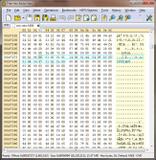I have an update to my previous post. I contacted the author of DiAVC and he thinks his codec produces blocking artifacts because the H.264 bitstream in wav.new.ts is corrupt. He pointed out that the bitstream does not parse successfully when decoded using the reference "JM" decoder (the one published by the committee which wrote the H.264 standard). Since this reference software is available for free (
http://iphome.hhi.de/suehring/tml/) I decided to downloaded and run it on the bitstream myself.
The decoder does indeed fail to decode the bitstream. It complains that an SEI message just after frame 14 has the wrong length.
In the original uncut video (test1.ts in the ftp 'wavelet' directory, which *does* decode successfully in the JM decoder), there are 19-byte SEI messages every frame (containing message types 0,1,4) and then, towards the end of every GOP, a 22-byte SEI message containing message types 0,1,6,4.
In the cut video (wav.new.ts) which you provided, there are 6-byte SEI messages every frame (containing message type 1) in the first (re-encoded) GOP until frame 14 when there is the SEI message containing types 1,2,6,4. This message should be 22 bytes, but the decoder thinks the message is 172 bytes long. When it sees the stop bit in the SEI message after 22 bytes, it aborts with an error message.
So the SEI message contents appears to be correct, but the length (which the decoder will be determining by the distance between NAL unit delimiters) is wrong. I suppose there is also the question of whether the SEI message should really be there at all because we are still in the first (re-encoded) GOP.
Anyway, I have uploaded to the ftp server a couple of log files showing NAL and SEI trace information up to the point where the decoder crashes.
I would recommend you use the JM decoder as a QA test of the output of SmartCutter. It would be a good way to ensure compliance with the H.264 standard and hopefully maximum compatibility with all the different players, camcorders, etc. that people are using.
Regards,
wavelet.
